This discussion of the Puritan, by Augustus Saint Gaudens, was published way back in 2007 as an Amazon Short. HT to Al M. for telling me that I know a descendant of this Puritan!
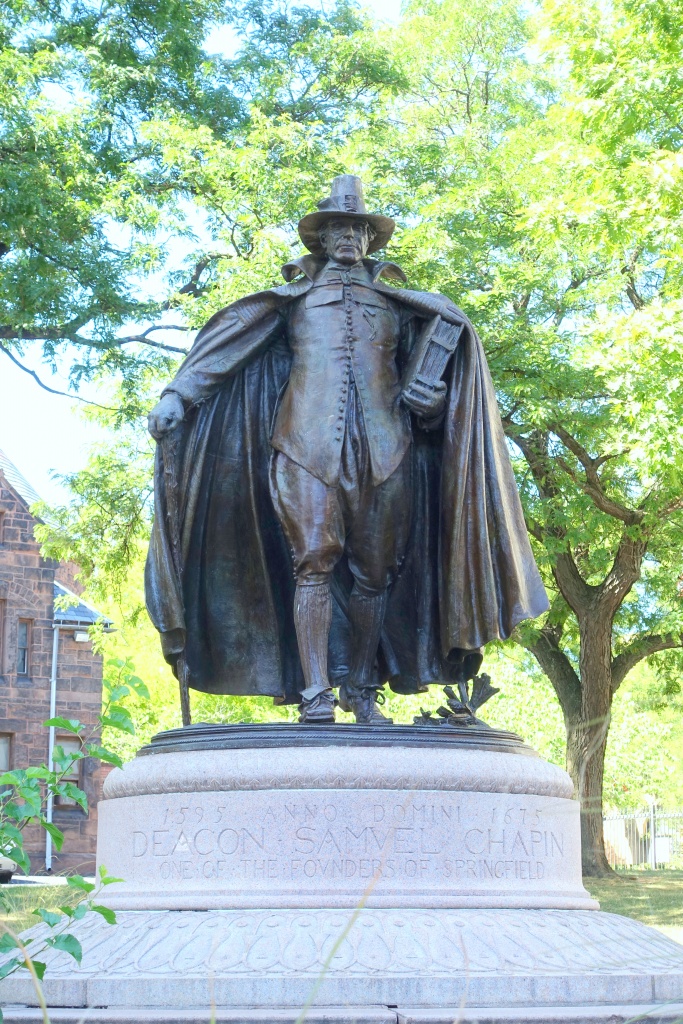
Would you like to know more about art than just what you like? Two routes to explore are learning to look at artworks more closely and learning more about the historical context in which it was created. This essay is divided into three sections:
- Questions that will help you look at the Puritan more closely. This is the method set out in more detail in Appendix A of Outdoor Monuments of Manhattan: A Historical Guide.
- My take the Puritan, based on my answers to those questions
- Brief historical background of the Puritan
NOTE: The original Puritan, an 8.5-foot tall bronze sculpture dedicated in 1886, stands in Merrick Park, Springfield, Massachusetts. It’s always better to see sculpture in the original, so at the end of this post, there’s a list of where you can see copies of the Puritan if you’re not in Springfield.
Part 1: Questions to help you look at the Puritan more closely
If you’ve ever picked up a piece of wood, stone or clay and tried to manipulate it into a recognizable shape, you know that every detail of a sculpture, from head and shoulders to knees and toes, is a matter the artist must decide. For a perfectionist such as Augustus Saint Gaudens, making such decisions might require more time than actually executing them. Homer Saint Gaudens recalled an episode in which his father tried to impress this attitude on his assistants:
“I am going to invent a machine to make you all good sculptors” [said Saint Gaudens].
The stillness promptly became uneasy.
“It will have hooks for the back of your necks, and strong springs.”
The stillness grew even more uneasy.
“Every 30-seconds it will jerk you fifty feet away from your work, and hold you there for five minutes’ contemplation.” [Reminiscences of Augustus Saint-Gaudens, ed. Homer Saint-Gaudens (New York: Century, 1913; repr. New York: Garland, 1976), I, 293]
Saint Gaudens is recognized as one of the best American sculptors, and his ability to work meticulously on the trees while keeping the forest in view helps explain how he achieved that status.
An artist conveys his unique point of view by the details he chooses to include, the way he represents them, and the emphasis he places on them. In order for us, as viewers, to grasp what the artist is saying—his theme—we must look carefully and systematically at those details. For me, thinking actively about any artwork makes looking at it much more enjoyable—like solving one of those mysteries where all the clues are provided, and one need only work out their significance.
Here are some of the questions I think one should ask to figure out the theme of the Puritan. My answers to them will come next week.
1. First impressions
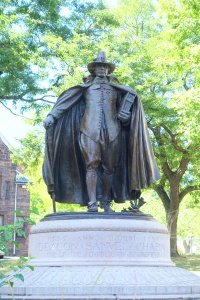
You glance at the Puritan, your eye wanders over it, and you end up looking … where? What feature strikes you as most important? What would you miss most if it were taken away or altered? It might be the face, the pose, or even the height or breadth of the sculpture. Chances are this is what the artist emphasized when designing the sculpture, and therefore it’s a strong indication of what he considered important.
What size is the sculpture? Is it as tall as you, taller, half life-size? The same artwork will have a profoundly different effect if it’s executed at twenty inches rather than twenty feet. The version of the Puritan in Springfield is 8.5 feet tall, without its pedestal. How would you feel if you stood beside or in front of it?
2. Subject
Who’s represented here? Use details of his costume and your knowledge of history to help identify the figure. Sometimes an artwork’s title will tell you the literal subject: sometimes, it will even suggest the theme the artist wanted to convey. The best works of art, however, are comprehensible without a verbal explanation. The title may add a fascinating twist in your thought, but it shouldn’t replace the need to look at the artwork.
3. Objects shown in the sculpture
Now look at the details of objects represented in the sculpture. It may help to contrast the Puritan with another sculpture: I’ve supplied a photo of Nathan Hale by Frederick MacMonnies, who was a student of Saint Gaudens in the early 1880s.
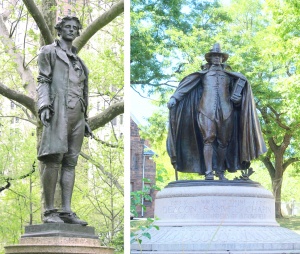


What are the proportions of the Puritan: is he tall or short, slender or sturdy?
Is he young, old, or middle-aged?
How does the Puritan hold his arms? How do the arms affect the way the cape falls? How does this affect the width of the sculpture, as compared to its height?
Is the Puritan moving or standing still? How do you know? Is he moving briskly or slowly, in a straight line or meandering? Again, how do you know? (Hint: look at the legs and the movement of his cape.)
What do you know so far about this man’s size, age, motion, and attitude?
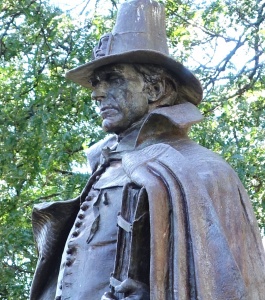

Now turn your attention to his face. First—because it’s the easiest feature to see—look at his mouth. Is this man grimacing, shouting, frowning, laughing? How do you know? What habitual expression would create the lines that bracket the Puritan’s mouth? Given the lines on his face, how old would you guess the man is: thirty, forty, fifty, sixty?
Can you read an expression in the Puritan‘s eyes? If so, what is it? If not, why not?
Hairstyle often provides a clue to a person’s character. How does the Puritan wear his hair? What effect does that have on your interpretation of him?
At this point, try to make a statement about this man’s character and actions. What sort of person is he? What is he doing?
Costume
In the MacMonnies sculpture, Nathan Hale’s shirt, pants, and vest fit snugly, revealing the body beneath. What kind of clothing does the Puritan wear? What’s the effect of this outfit? Do you know anything about the Puritan attitude toward the human body that might help explain why this man is bundled from head to toe?



Hale’s high collar emphasizes his bare neck by standing away from it. What does the collar of the Puritan’s cape do to his neck and face? How does the fabric of his cape behave: does it swirl about, hang straight, fly backward like Superman’s? Compare the cape on a sculpture such as Saint Gaudens’s Sherman.
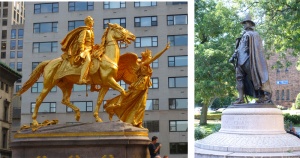

Hale is hatless, allowing you to see his expression and his tousled hair. What’s the effect of the Puritan’s towering hat? What’s the effect of its wide brim?
What have you learned about the Puritan from his costume? Use this to adjust your earlier description, refining what type of person he is and what he’s doing.
Props (items held by the figure)
Describe the shape and texture of the staff in the Puritan’s right hand. Judging by where it rests on the ground, what is he using it for? Think of people you’ve seen using a cane or crutches: where do they position the lower end to give them support? Does the Puritan appear feeble or in need of support? What else might he use the staff for, if not support?


Compare the Puritan’s staff to the elegant cane carried by Houdon’s George Washington. How does the finish on the Puritan’s cane differ? How does that fit in with what the Puritan is doing or might do with his cane?
In the crook of his left arm, the Puritan carries a huge book. What book do you think it is? How large is it in comparison to his forearm or torso? What might he plan to do with such a large volume?
Revise your tentative statement about the Puritan based on what you’ve observed about his staff and book. Consider his attitude and purpose: if he could speak to you as he approached, what might he say?
4. Attributes of the sculpture
What color is the sculpture? If it were carved of dazzling white marble or dark granite, how might your reaction differ?
Look at the shadows on Nathan Hale and Washington. Is more of the Puritan in deep shadow, or less? Which parts of the Puritan’s outfit cast shadows, and where? Do the shadows affect your impression of the figure?
Often a sculptor draws a viewer’s attention to part of a sculpture either by an interesting texture, or by the contrast of textured and smooth surfaces. To which parts of the sculpture do the various textures of the Puritan draw attention?
What can you add to your statement about the Puritan based on color, shadows, and texture?
5. Overview



Back to the big picture. Is the Puritan swaying or upright? What does that suggest about him? Is he symmetrical or asymmetrical? What’s the effect?
Summary
From observing the details, what do you know about this figure’s character and actions? Are any of the elements emphasized by being repeated, or by being presented very prominently?
What means did the artist use to make your eye linger on the part that you noticed at first glance: color, composition, pose …? As you now understand the sculpture, why is that particular object or detail important?
What message do you think Saint Gaudens is trying to convey about this figure’s thoughts and actions? Try to boil your summary down to one grammatically correct sentence: this forces you to state what the subject is and what it is about the figure (an action, a thought, an attitude) that the artist considers worthy of your notice.
Copies of the Puritan
The Saint Gaudens National Historic Site has an over-life-size plaster version of the Puritan which was exhibited in Paris in 1900. The face, staff, and cape of the plaster version are slightly different. Its fascinating to see what Saint Gaudens decided needed changing over the decade after the Springfield sculpture was dedicated. For photos see Dryfhout, The Work of Augustus Saint-Gaudens, pp. 164 and p. 165, illus. 125-10.
Saint Gaudens created a scaled-down Puritan, thirty-one inches high, with an 1899 copyright. Dryfhout lists twenty-five known copies, including these in public collections:
- Louisiana: R.W. Norton Gallery, Shreveport.
- Massachusetts: Addison Gallery of American Art, Phillips Academy, Andover. Amherst College, Mead Art Museum. Museum of Fine Arts, Boston. Springfield Museum of Fine Arts. Williams College Museum of Art, Williamstown.
- Missouri: Saint Louis Art Museum.
- Nebraska: University of Nebraska, Sheldon Memorial Art Gallery, Lincoln.
- New Hampshire: Saint Gaudens National Historic Site, Cornish.
- New Jersey: Princeton University, Scheide Library.
- New York: Cornell University, Johnson Museum, Ithaca. Metropolitan Museum of Art, New York. New-York Historical Society. Sagamore Hill National Historic Site, Oyster Bay, Long Island.
- North Carolina: North Carolina Museum of Art, Raleigh.
- Oklahoma: Gilcrease Institute of History and Art, Tulsa.
- Pennsylvania: Allentown Art Museum. Carnegie Institute Museum of Art, Pittsburgh.
- South Carolina: Brookgreen Gardens, Murrells Inlet.
- Wisconsin: Milwaukee Art Center.
For Philadelphia, Saint Gaudens reworked the Puritan and called it the Pilgrim. It was dedicated in Fairmount Park, in 1904.


More
- Next week: my take on the Puritan, based on my answers to the questions above.
- In Getting More Enjoyment from Sculpture You Love, I demonstrate a method for looking at sculptures in detail, in depth, and on your own. Learn to enjoy your favorite sculptures more, and find new favorites. Available on Amazon in print and Kindle formats. More here.
- Want wonderful art delivered weekly to your inbox? Check out my free Sunday Recommendations list and rewards for recurring support: details here.